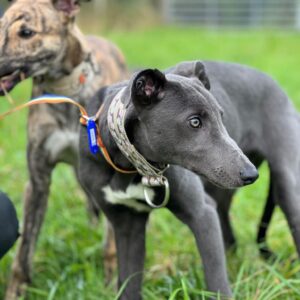At PAWS, we come across all kinds of dogs, from all backgrounds, breeds, personalities and ages. Many PAWS dogs have had a great deal of experience in their short lives, some good and sadly, more than most, some really bad experiences. It is part of our job to assess all the dogs that come into our care, treat their injuries, their hurt and give them a safe place where they can eventually find their forever home and get adopted. Our biggest aim is to try and match dogs to the best possible home for them. Just like humans, all dogs are different and can come with their own individual needs, sometimes it can be a medical condition they live with or sometimes it’s behavioural and they need a lot of time and understanding in any new potential home. As you can imagine, a lot of rescue dogs may have come from very stressful situations, they may have spent a lot of their life being passed from pillar to post being rehomed, or they may have had a very loving home, until a change in their owner’s circumstances recently and now they find themselves in a rescue shelter and find it hard to understand or they may have been involved in a neglect or abuse case. This can result in a dog having fear or anxiety issues. Often fear and anxiety in dogs can result in behavioural problems like separation anxiety, shredding furniture, excessive barking, leash reactivity on walks like pulling, lunging etc towards other dogs and people to name the most common issues.
A dog with anxious or fear issues can require a lot more understanding from their owners. When a dog is adopted from PAWS, we like to try and take all the necessary steps to ensure the dog has found the right home and has been adopted permanently where both owner and dog is happy. Dogs can absolutely get over being fearful when their anxiety is managed properly and they have a little patience and understanding. The best thing owners can do to manage and look out for any fear or anxious behaviour in their dogs, is first be aware of the signs of fearful behaviour. Dogs will exhibit signs of frightened or stressed behaviour in tense situations like having a tucked tail underneath him, excessive drooling, panting excessively, rigid or stiff posture, pacing or circling in the same spot or whale eye i.e. Showing the whites of their eyes. These behaviors might be exhibited in situations where there is loud noise, too many people or dogs, thunderstorms or fireworks or too many new things at once. The most important thing a dog needs when exhibiting these signs is understanding and patience and not be rushed. When you are in tune with your dog and can spot these signs, you have to remove your dog from the stressful situation or manage his fear by removing him from the stressor and praising him when he has a positive reaction to the stressor. A dog exhibiting fear should never be forced to confront stressful situations or contend with what’s scaring him as this is likely to push him to defend himself and lash out and affect the trust he has in you as his guide.
It’s important to know that the fear your dog experiences is an emotion and not necessarily a bad thing, your dog is an animal and fear helps him realise a danger and act accordingly. It is excessive fear and the inability to manage it or letting it get so intense that fear affects their ability to relax or enjoy life and create difficult behavioural issues that can make it hard to manage that’s the issue.
So what can we do when our dog is highly fearful or anxious?
Visit your veterinarian. The first step should be to make sure your dog has a clean bill of health and is not suffering from an underlying health condition that could be affecting his behaviour. Often, dogs that experience a sudden change in behaviour stems from an underlying issue going untreated. So be sure to first tick this off the list as a reason for your dog being fearful or excessively anxious.
Be sure to get professional help from a qualified trainer or behaviourist. If your dog is experiencing extreme fearful or anxious behaviour in day to day life, ensure to seek professional help from a trainer or behaviourist that uses positive reinforcement methods only. It’s really important to be able to understand your dog and treat their fear with patience and kindness and a reputable trainer or behaviourist will assess your dog and help you understand his fear and calming signals.
Help build your dog’s confidence. Developing your dog’s confidence can help him overcome his fearfulness because these two states of being are not compatible. Anything that allows a dog to experience success is good for his self esteem and adds to his self-confidence. Training your dog to standard obedience exercises, targeting, responding to their names or performing tricks—can build confidence. So can getting their nourishment from canine enrichment like food-reward puzzles or food-stuffed toys like kongs and canine connectables because accessing the food is an accomplishment. Play is also a way to help dogs feel confident.
Practice positively reinforcing your dog to have confidence and be calm in stressful situations- classical conditioning. Always start at a low level in potentially stressful situations so that your dog’s fear is not induced. Then, gradually, during many sessions over a period of weeks or months, the intensity of what frightens him is increased so that he can get used to it at each level before moving on to the next. Scary things are made less scary by being smaller, slower, quieter, farther away or otherwise less intense. Exposing your dog to what frightens them too quick will likely make your dog’s anxiety worse. Classical conditioning is desensitising your dog to something that makes him fearful, for example, if it is passing new dogs in the park. Asking your dog for a sit when a dog is approaching in the distance and rewarding and praising your dog for keeping his focus on you. Then acting accordingly by removing your dog from the situation by walking the opposite direction from the approaching dog if they begin to show signs that they are going to react negatively to the approaching dog through fear or otherwise. This will positively reinforce the experience to your dog that he will not be forced to interact with the new dog if he experiences stress and fear. He will also learn that when he ignores the dog passing or approaching him on a walk and he’ll be rewarded and praised by you and have a positive experience.
Classical conditioning consists of counterconditioning what frightens the dog with something the dog loves more than anything else; like his owners and tasty treats, eventually, the dog realizes that the scary thing predicts the wonderful thing. If your dog fears people, then every time he sees someone, he should immediately receive a tasty treat. Eventually, the dog will have a positive emotional reaction to seeing a person, because he knows that something good is about to happen. Exposing your dog to the trigger that scares him, starting at very low levels of intensity and gradually working up to more intense exposures, is most effective. In practice, desensitization and classical counterconditioning are often done together
Build a good foundation. We have spoken previously in the PAWS Kennel Diaries blog about building the bond with your dog. A good foundation for helping dogs overcome their fears is built from many aspects of their daily life. Good nutrition, regular exercise and positive routines will all help your dog see you as his guide and protector.
It takes time and patience to manage a fearful dog. Always be gentle, positive and kind towards your dog. Never use physical force or corrective behaviour and never use any type of punishment or correction which scares or intimidates your dog.
Helping a dog who lives in fear is a common undertaking—many people, knowingly or not, end up living with a dog who is afraid. To succeed in treating a fearful dog so that he can conquer his fears requires knowledge, consistent effort and extraordinary patience.








